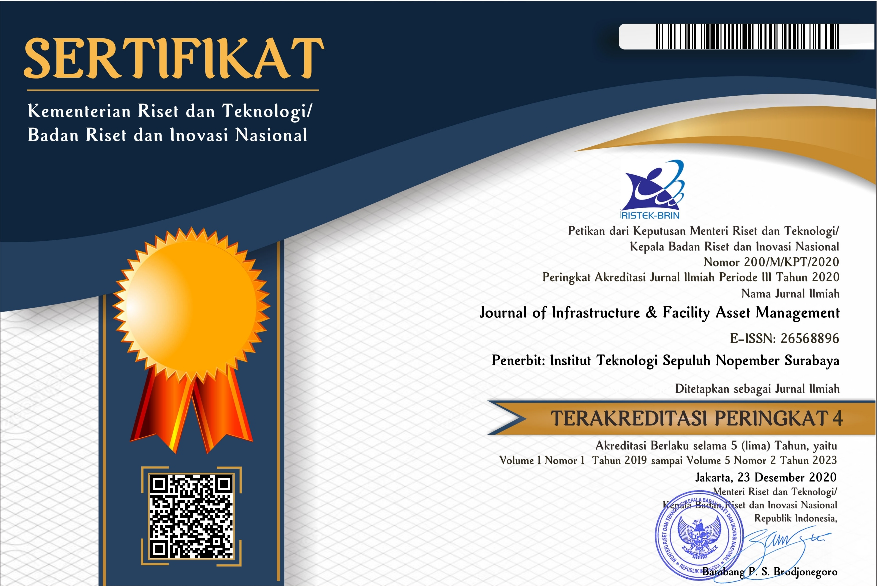Analysis of Existing Slope Reinforcement Design on Clay Shale Soil and Its Alternative Modifications: A Case Study of the Awunio – Lapuko Road Section Sta 4+955 – 5+015 in the Southeast Sulawesi Province
Abstract
Full Text:
PDFReferences
Abramson, Lee. W., Lee, Thomas. S., Sharma, S., & Boyce, G. M. (2002). Slope Stability and Stabilization Method (2nd ed.). John & Wiley Sons, Inc.
Alhadar, S., Asrida, L., Prabandiyani, S., & Hardiyati, S. (2014). “Analisis Stabilitas Lereng Pada Tanah Clay Shale Proyek Jalan Tol Semarang-Solo Paket VI STA 22+700 sampai STA 22+775”. Jurnal Karya Teknik Sipil, Vol. 3, Hal.: 336–344. Semarang.
Departemen Permukiman & Prasarana Wilayah. (2002). Panduan Geoteknik 4: Desain dan Konstruksi. WSP International. Bandung.
Hardiyatmo, H. C. (2003). Mekanika Tanah II (3rd ed.). Gadjah Mada University Press.
Hardiyatmo, H. C. (2006). Penanggulangan Tanah Longsor dan Erosi. Gajah Mada University Press.
Hardiyatmo, H. C. (2010). Analisis & Perancangan Fondasi II. Gadjah Mada University Press.
Hardiyatmo, H. C. (2014). Analisis & Perancangan Fondasi (2nd ed., Vol. 1). Gadjah Mada University Press.
Manudianto, Dedy., Endah, Noor., & Siahaan, Hardy P. (2023). “Alternative of Soil Improvement Methods on Organic Soil Using Preloading and Vertical Piles for Embankment with Varied Heights. Case Study: Construction of Batanjung Port Access Road in Pulang Pisau Regency, Central Kalimantan”. Journal of Infrastructure and Facility Asset Management. Vol. 5, No. 1, Hal.: 11-26. Surabaya.
Mochtar, I. B. (2021). The Phenomena of Cracked Soil. Institut Teknologi Sepuluh Nopember.
NAVFAC DM-7. (1971). Design Manual - Soil Mechanics, Foundations, and Earth Structures. U.S Naval Publications and Forms Center.
Satrya, T. R., Soemitro, R. A. A., Maulana, M. A., & Soetanto, R. (2019). “Assessment of Infrastructure Assets InducedbyWaterLevel Fluctuation along the Bengawan Solo River”. Journal of Infrastructure and Facility Asset Management. Vol. 1, No. 2, Hal.: 105. Surabaya.
Seftian, E., Sumampouw, R. J. E. R., & Balamba, S. (2015). “Analisis Daya Dukung Tiang Pancang Dengan Menggunakan Metode Statik dan Calendring Studi Kasus : Proyek Pembangunan Manado Town Square 3”. Jurnal Sipil Statik, 3(9), 631–643. Manado.
Shoffiana, Nur A., Lastiasih, Yudhi., & Satrya, Trihanyndio R. (2022). “Comparison of Embankment Reinforcement Requirements with Geotextile on Soft Soil with 2D and 3D Slope Stability Analysis Methods”. Journal of Infrastructure and Facility Asset Management. Vol. 4, No. 2, Hal.: 65-78. Surabaya.
SNI 2847. (2013). Persyaratan Beton Struktural Untuk Bangunan Gedung. www.bsn.go.id
SNI 8460. (2017). Persyaratan Perancangan Geoteknik. www.bsn.go.id
Soemitro, R. A. A., & Suprayitno, H. (2019). “Preliminary Reflection on Basic Problematics of National Public Infrastructure Financing in Indonesia”. Journal of Infrastructure and Facility Asset Management. Vol. 2, No. 1, Hal.: 51. Surabaya.
Suprayitno, H., Soemitro, R. A. A., Maulana, M. A., & Hesna, Yervi. (2020). “Preliminary Reflection on Performance Indicator and Performance Factor for Infrastructure Asset Management”. Journal of Infrastructure and Facility Asset Management. Vol. 2, No. 1, Hal.: 35. Surabaya.
Tarigan, B. A. C., Mochtar, I. B., & Arif, M. (2020). “Rekomendasi Solusi untuk Mengatasi Kelongsoran pada Lereng Jalan Akses PLTA Musi (KM 5 dan KM 8) dengan Pendekatan Cracked Soil”. Jurnal Teknik ITS, 9(2), 265–271. Surabaya.
DOI: http://dx.doi.org/10.12962%2Fjifam.v6i1.19889
Refbacks
- There are currently no refbacks.
Visitor :
Flag Counter

Journal Of Infrastructure & Facility Asset Management by Institut Teknologi Sepuluh Nopember is licensed under a Creative Commons Attribution-ShareAlike 4.0 International License.





